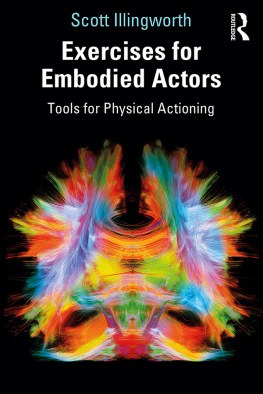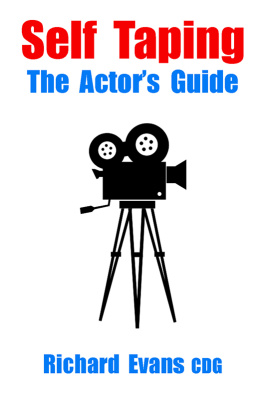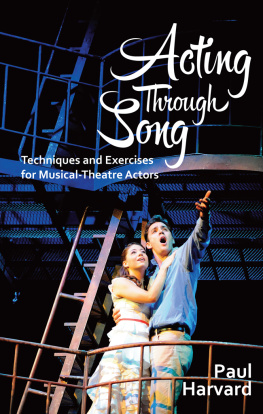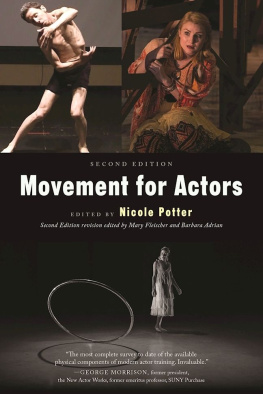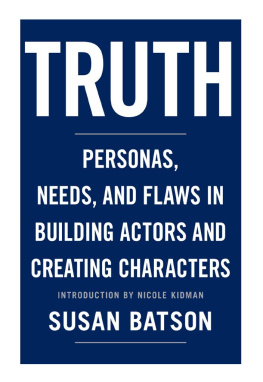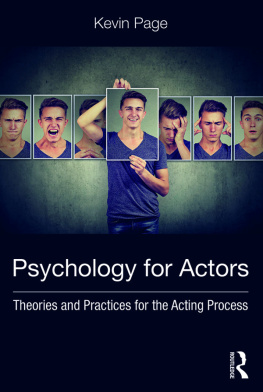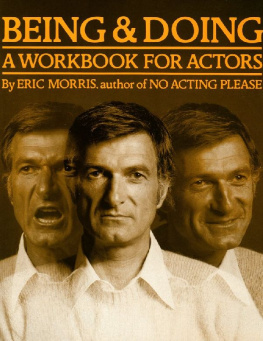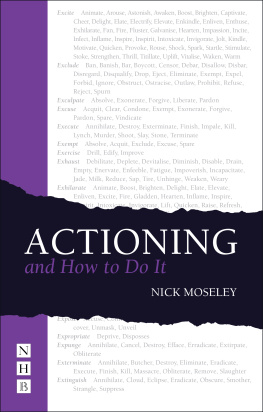Exercises for Embodied Actors
Exercises for Embodied Actors: Tools for Physical Actioning builds on the vocabulary of simple action verbs to generate an entire set of practical tools from first read to performance that harnesses modern knowledge about the integration of the mind and the rest of the body.
Including over 50 innovative exercises, the book leads actors through a rigorous examination of their own habits, links those discoveries to creating characters, and offers dozens of exercises to explore in classrooms and with ensembles. The result is a modern toolkit that empowers actors to start from their own unique selves and delivers specific techniques to apply on stage and in front of the camera.
This step-by-step guide can be used by actors working individually or by teachers crafting the arc of a course, ensuring that students explore in physically engaged and dynamic ways at every step of their process.
Scott Illingworth is a professor in the Graduate Acting Program at New York Universitys Tisch School of the Arts and a freelance director. He has taught, lectured, and directed at universities and schools across the United States and internationally. He is a member of the Stage Directors and Choreographers Society, a Guild Certified Feldenkrais Practitioner, and a Fulbright grant recipient. For more information about Scott, please visit www.physicalactioning.com.
First published 2020
by Routledge
52 Vanderbilt Avenue, New York, NY 10017
and by Routledge
2 Park Square, Milton Park, Abingdon, Oxon OX14 4RN
Routledge is an imprint of the Taylor & Francis Group, an informa business
2020 Taylor & Francis
The right of Scott Illingworth to be identified as author of this work has been asserted by him in accordance with sections 77 and 78 of the Copyright, Designs and Patents Act 1988.
All rights reserved. No part of this book may be reprinted or reproduced or utilized in any form or by any electronic, mechanical, or other means, now known or hereafter invented, including photocopying and recording, or in any information storage or retrieval system, without permission in writing from the publishers.
Trademark notice: Product or corporate names may be trademarks or registered trademarks, and are used only for identification and explanation without intent to infringe.
Scott Illingworth orcid: 0000-0003-4352-7868
Paperback cover image is a full brain tractogram by Sherbrooke Connectivity Imaging Lab (SCIL). Tractography uses specific MRI techniques and computer software to generate a model of nerve fiber pathways in the brain.
Library of Congress Cataloging-in-Publication Data
Names: Illingworth, Scott, author.
Title: Exercises for embodied actors : tools for physical actioning / Scott Illingworth.
Description: New York, NY : Routledge, 2020. | Includes bibliographical references and index. Identifiers: LCCN 2019049616 (print) | LCCN 2019049617 (ebook) | ISBN 9780367433833 (hardback) | ISBN 9780367433840 (paperback) | ISBN 9781003002819 (ebook)
Subjects: LCSH: Movement (Acting)
Classification: LCC PN2071.M6 I45 2020 (print) | LCC PN2071.M6 (ebook) | DDC 792.02/8--dc23
LC record available at https://lccn.loc.gov/2019049616
LC ebook record available at https://lccn.loc.gov/2019049617
ISBN: 978-0-367-43383-3 (hbk)
ISBN: 978-0-367-43384-0 (pbk)
ISBN: 978-1-003-00281-9 (ebk)
For Jamie
My life is full of generous mentors and teachers. Allyn Sitjar, Kevin Kittle, and Lavinia Plonka were my earliest models of curiosity and rigor in theatre. The Theatre School at DePaul University in Chicago was a tremendous home for my advanced education and introduced me to Joe Slowik, Patrice Egleston, Phyllis Griffin, Betsy Hamilton, John Jenkins, Damon Kiely, and many others who all offered profound insight into acting as a craft and teaching as a profession. My time training to become a Guild Certified Feldenkrais Teacher under Julie Casson Rubin and Paul Rubin transformed my view of the body and understanding of how the mind is part of the whole. Most of all I must thank Mark Wing-Davey and my colleagues and students in the Graduate Acting Program at New York Universitys Tisch School of the Arts. Marks relentless curiosity coupled with his unwavering belief in me is the reason I have the space and time to continually develop this work.
I also owe a debt to a variety of people who helped in the process of writing this book. Specific thanks to Alexandra Templer for indispensable editing and research assistance, Mary Escobar for her graphic design work, Lisa Benavides-Nelson for her insightful feedback, and Mike May for his metaphor about train conducting.
Finally, I am mindful that none of those past or current opportunities would exist without my parents and sister, who never expressed a bit of doubt about my life in the theatre, or the unparalleled support of my wife, Jamie Wolfe, who is a partner in all things.
Actors are makers. It is an important way to think about the work. Makers craft a thing over time until it is in a usable state for others. Making is a process and the process itself has everything to do with the quality and nature of the product. No matter how inspired the moment when you begin, it still takes time to make a thing. If I was building a table, for instance, just the vision in my mind of that table would not be the same as the finished table sitting before me. Many factors, from the materials I use to my own skills and experience, impact how close I will come to crafting the table I imagined. Makers are not magicians (which, in reality, is also a trade of making and refining illusions). Watching a performance can feel magical, though. Many of us get into the profession because of the experiences we had as audience members, but using a table is no closer to building a table than watching acting is to acting itself.
What I offer in this book are lots of tools to make your work practical tools that will serve you in every version of the job I can imagine (from theatre, to screen, to the most last-minute audition, to virtual reality, to spaces we have yet to invent but where humanness needs representing). After using these tools, you can stand back and say Wow, I made that table, instead of Wow, I really love how I feel while making this table. There will be many moments of the joy of doing, but only because your focus is on the doing itself. I want you to experience the joy of doing it well and with purpose, not the joy of merely getting to do it. This is because, like the table, your work has a function beyond you. That function can be amusement or incitement to revolution or generating empathy or shock, or many other goals. Knowing the purpose of the thing youre making is an important part of making it.
In her iconic book, Improvisation for the Theater, Viola Spolin wrote We learn through experience and experiencing, and no one teaches anyone anything. In that spirit I am doing here the same thing I try to do in the classroom provide exercises that are experiments for you to conduct. Experiments are questions built to test an idea. They dont presume an outcome and they leave space for the designer of the experiment to be proven wrong and try again. I crafted a process of inquiry you can use that happens, by the end, to engage you deeply physically, moment-to-moment, with whatever role youre playing and leaves you ready to experience the great joy of living in performance with others.
All the experiments spring from a vocabulary that both the experienced actor and novice share: action verbs. The vocabulary of actions is one you can use in any setting. Your director doesnt have to read this book for them to understand what you mean when you say that you want to squeeze your partner with a line of text or in an unspoken moment. They have their own embodied experience of that word, some of which likely overlaps with yours. Many actors find that when they start using this language with partners or in rehearsal others quickly pick up on it as a way to express their own impulses with greater specificity.

